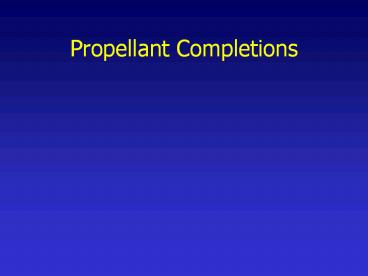Propellant Completions PowerPoint PPT Presentation
1 / 19
Title: Propellant Completions
1
Propellant Completions
2
Principles - HEGF, etc.
- The pressure used for fracturing is provided by
the rapid combustion (burning) of propellant in
the wellbore, which generates large quantities of
CO2 gas. When this pressure exceeds the in-situ
stresses, the rock fails in tension, and the high
velocity gasses erode the face of the subsequent
fractures. The operation may be conducted in both
open and cased wellbores.
3
Tradenames
- The technique is known by several generic names,
such as Dynamic Gas Pulse Loading
(Servo-Dynamics), High Energy Gas Frac (Sandia
National Laboratories), and Controlled Pulse
Fracturing (Mobil Research and Development
Corporation). - Stimgun and Stimtube (MOC)
4
Explosive Stimulation (Well Shooting)
- Liquid or solidified nitroglycerin - since
1800s. - The intended to fracture or "rubbilize" the rock
to alter permeability near the wellbore. - Brief, extremely high and compressive pressure
pulse, or shock wave is generated, which far
exceeds the tensile strength of the formation
rock.
5
Explosive Stimulation (Well Shooting)
- The high pressures of the detonation cause the
rock to yield and compact. - After the stress wave passes, the rock unloads
elastically, leaving an enlarged, deformed
wellbore, a zone of compacted rock and a region
of greater compressive stress. This crushed
region contains a substantial quantity of fines,
which reduce permeability and productivity around
the wellbore.
6
Propellant Technology
- Explosives and propellants have similar energy
contents, but different ingredients. - Both release energy as they "burn", and the type
of energy released is directly related to the
rate at which they chemically convert into gas. - For inducing multiple, radial fractures, the
rate at which the borehole is pressurized is the
controlling factor. - Peak pressure is important, but secondary.
7
(No Transcript)
8
Principles
- A burst of high-pressure gas or a fluid "spear"
is driven into the perforation at extremely high
velocities - to remove crushed-zone damage and to
create short fractures in the formation. - Trade literature suggests that this can result in
negative skin. - "Cleaner perfs mean reduced treating pressures -
500 to 1,300 psi lower than for similar wells
perforated in an underbalanced condition. - Significantly lower treating pressures mean
significantly lower treatment costs."
9
StimgunTM
- Propellant sleeve over a conventional assembly.
- When the guns detonated, the propellant sleeve is
ignited instantly, producing a burst of
high-pressure gas. - This gas enters the perforations, breaking
through any damage around the tunnel, creating
fractures in the formation. - As the gas pressure in the wellbore dissipates,
the gas in the formation surges into the wellbore
carrying with it damaging fines. - StimGun, StimTube and POWRPERF are service
marks/trademarks of Marathon Oil Company
10
The StimGun assembly used in the Mara-Stim
process
- The propellant is ignited by the pressure and
shock wave of the shaped charges as they
penetrate the gun, casing and formation. - The propellant sleeve, on initial inspection,
would appear similar to a piece of PVC pipe held
in position by slightly larger end subs on the
carrier.
11
(No Transcript)
12
The Players (Stimgun)
- Marathon Oil Company
- Owen Oil Tools, Inc. (manufactures the StimGun
and the StimTube Tool) - HTH Technical Services, Inc.
- Computalog Ltd.
- Halliburton Energy Services, Inc.
- Baker-Atlas
13
The StimTube Tool
- Same solid propellant technology as StimGun tool
- StimTube tool creates a surge of high-pressure
gas downhole. The surge can clean up damage and
initiate fractures in perforated cased and open
hole wells. - Runs on standard tubing-conveyed, electric line
or slickline equipment.
14
The StimTube Tool
- Positioned across the formation of interest.
- Ignition over the tool's entire length. The burn,
from inside out, produces constantly increasing
gas volumes. - Fractures are initiated.
- As wellbore pressure declines after the burn, gas
surges back out of the formation, carrying
damaging fines with it, providing enhanced
communication between the formation and wellbore.
15
The PerfStim Process
- Halliburtons extreme overbalanced technique
- In the PerfStim process, an extreme overbalanced
condition is created - pressure gradients of at
least 1.4 psi/ft (31 kPa/m). - A small volume (usually no more than a 300-ft
column) of non-damaging fluid is placed above the
gun, then pressured with nitrogen. If needed, a
liquid can be bullheaded on top of the nitrogen
column.
16
The PerfConSM Process
- Extreme overbalance technology to perforate and
inject a Halliburton sand consolidation resin - When the guns fire, the resin surges into the
formation around the perforations. - Pump catalyst to set the resin.
- The initial high-pressure, high-flow-rate surge
removes debris from the perforation tunnel and
crush zone. - Can be used through existing perforations.
17
POWR?PERFSM
- The POWR?PERFSM process incorporates an agent
that scours the perforations to remove the
crushed zone damage, often producing negative
skin.
18
KISS Charge vs. Big-Hole Charge
- Designed to just penetrate the formation while
the high pressure gas breaks through the crushed
zone in the tunnel and creates fractures in the
formation. - KISS charges created holes in the casing that
were equal to or larger in diameter than those
created by conventional big-hole perforating
charges. - Perforation depth was reduced, so there was far
less damage to the formation as well as a
significantly reduced crushed zone (less than
one-third of a conventional big-hole charge).
19
Servo-DynamicsDGPL/STRESSFRAC
- Produces fractures extending several feet.
- Restricts vertical fracture growth
- Multiple zones without the need for mechanical
isolation. - under non-damaging fluids, such as liquid CO2,
methanol, diesel fuel, kerosene distillates, or
other similar liquids - multiple fractures which intercept and connect
with the natural fracture pattern - in single run lengths up to 304.80 m (1,000 ft.)
- in horizontal wells in open hole, pre-perforated
liners, cemented and perforated casing. tubing
conveyed, with or without packers, and with or
without tubing anchors

